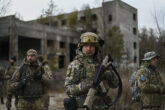July 10, 2025
How Russia Could Exploit a Vacuum in Europe
This article was originally published on Foreign Affairs.
The NATO summit held two weeks ago in The Hague delivered on the low expectations the allies had set for it. Amid fears that U.S. President Donald Trump would blow up a normal agenda, NATO leaders significantly pared back the program, taking hard discussions on issues such as support for Ukraine, NATO’s relations with Russia, and Russian hybrid attacks in Europe off the table. But the summit did close with a historic agreement by most allies, Spain being a notable exception, to increase members’ defense spending to five percent of GDP over the next ten years, with 3.5 percent earmarked for core military spending and 1.5 percent for hardening civilian infrastructure and overall resilience. The pledge to spend more on defense, in addition to NATO Secretary General Mark Rutte’s sycophantic praise of Trump at the summit, smoothed the way for Trump to stick largely to the summit’s highly choreographed script, keeping the alliance’s cohesion intact. Trump even appeared to leave The Hague with a newfound appreciation for NATO members, telling reporters: “These people really love their countries. It’s not a rip-off, and we’re here to help them.”
Any sense of relief among the allies, however, may be short-lived. The relatively positive headlines coming out of the summit obscure the storm brewing across the Atlantic. The Trump administration is undertaking a sweeping force posture review slated for release in late summer or early fall that could fundamentally reshape the U.S. military’s global footprint. If that process results in a significant and swift reduction of U.S. forces in Europe, an outcome that administration officials have publicly suggested is possible, the alliance will become more vulnerable to further Russian aggression.
Putin would assume that with a smaller U.S. presence in Europe, the West would be forced to favor de-escalation, creating an environment the Kremlin would view as exceptionally permissive and paving the way for increasingly brazen acts.
Europe is stepping up in a big way, and defense budgets are rising, but it will take time to ramp up production and deliver the capabilities that the United States currently provides on the continent. The United States may see fit to make some force adjustments in Europe that allow it to bolster its defense posture in Asia to counter rising threats from China. But Washington must carefully plan any such shift, leaving U.S. forces in place long enough that Europeans can work to fill the coming gaps and retain their credible deterrent against Russia. It is critical that any drawdown be closely coordinated with NATO military authorities and that allies agree in advance to cover lost capabilities. Otherwise, Russian President Vladimir Putin will be tempted to take advantage of a weakened alliance.
Read the full article on Foreign Affairs.
More from CNAS
-
Ukraine Negotiations: Prospects and Pitfalls of Peace
This week Brussels Sprouts breaks down the latest negotiations on Ukraine. American officials told reporters that they had resolved or closed gaps around 90 percent of their d...
By Andrea Kendall-Taylor & Jim Townsend
-
Transatlantic Security / Middle East Security
The Russia-Iran Partnership: A Geopolitical Balancing ActIt has been almost a year since Russia and Iran signed their comprehensive strategic partnership. That deal established a 20-year partnership between the two countries coverin...
By Andrea Kendall-Taylor & Jim Townsend
-
Defense / Transatlantic Security
Ukraine’s Catch-22 MomentThis article was originally published in the Financial Times. In Joseph Heller’s wartime classic, Catch-22, the protagonist Yossarian seeks out the US army surgeon Doc Daneeka...
By Franz-Stefan Gady
-
Ex-Nato Supreme Allied Commander Warns of Russia’s Territorial Ambitions
Gen. Philip Breedlove (Ret.), member of the CNAS board of advisors, told Fox News Digital he sees “a lot of truth” in the German foreign minister’s warning about Russia, sayin...
By Philip Breedlove




